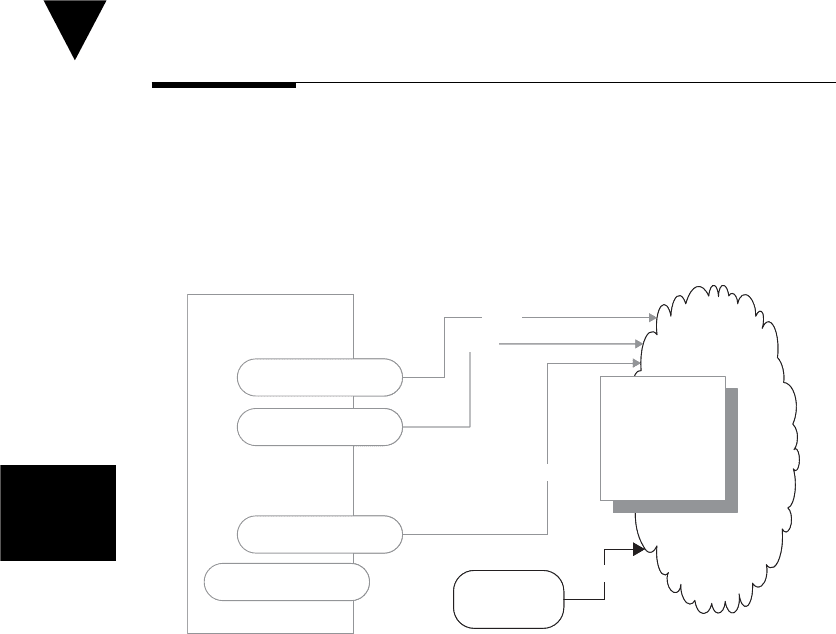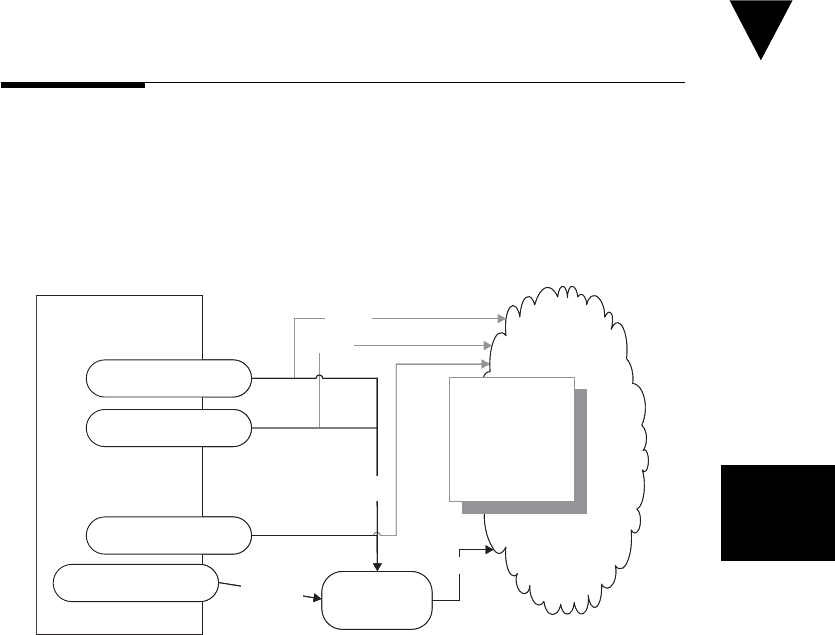Meszaros G. xUnit Test Patterns Refactoring Test Code
Подождите немного. Документ загружается.

This page intentionally left blank

499
Chapter 22
Fixture Teardown Patterns
Patterns in This Chapter
Teardown Strategy
Garbage-Collected Teardown . . . . . . . . . . . . . . . . . . . . . . . . . . . 500
Automated Teardown. . . . . . . . . . . . . . . . . . . . . . . . . . . . . . . . . 503
Code Organization
In-line Teardown . . . . . . . . . . . . . . . . . . . . . . . . . . . . . . . . . . . . 509
Implicit Teardown . . . . . . . . . . . . . . . . . . . . . . . . . . . . . . . . . . . 516
Fixture
Teardown
Patterns

500
Chapter 22 Fixture Teardown Patterns
b
Garbage-Collected Teardown
How do we tear down the Test Fixture?
We let the garbage collection mechanism provided by the programming
language clean up after our test.
A large part of making tests repeatable and robust is ensuring that the test fi x-
ture is torn down after each test and a new one created for the next test run.
This strategy is known as a Fresh Fixture (page 311). In languages that provide
garbage collection, much of the teardown can happen automatically if we refer
to resources via local and instance variables.
How It Works
Many of the objects created during the course of our test (including both fi xture
setup and exercising the SUT) are transient objects that are kept alive only as
long as there is a reference to them somewhere in the program that created them.
The garbage collection mechanisms of modern languages use various algorithms
to detect “garbage.” What is most important, though, is how they determine
that something is not garbage: Any object that is reachable from any other live
object or from global (i.e., static) variables will not be garbage collected.
When running our tests, the Test Automation Framework (page 298) creates
a Testcase Object (page 382) for each Test Method (page 348) in our Testcase
Fixture
SUT
Setup
Testcase Class
tearDown
test_method_1
test_method_2
test_method_n
Setup
Setup
Garbage
Collection
Teardown
Fixture
SUT
Setup
Testcase Class
tearDown
test_method_1
test_method_2
test_method_n
Setup
Setup
Garbage
Collection
Teardown
Garbage-
Collected
Teardown

501
Class (page 373) and adds those objects to a Test Suite Object (page 387). When-
ever a new test run is started, the framework typically throws away the existing
test suite and builds a new one (to be sure everything is fresh). When the old test
suite is discarded, any objects referenced only by instance variables in those tests
become candidates for garbage collection.
When to Use It
We should use Garbage-Collected Teardown whenever we possibly can because
it will save us a lot of effort!
If our programming takes place in an environment that doesn’t support garbage
collection, or if we have resources that aren’t garbage collected automatically (e.g.,
fi les, sockets, records in a database), we’ll need to destroy or free those resources
explicitly. If we are using a Shared Fixture (page 317), we won’t be able to use
Garbage-Collected Teardown unless we do something fancy to hold the reference
to the fi xture in such a way that it will go out of scope when our test suite has
fi nished running.
We can use In-line Teardown (page 509), Implicit Teardown (page 516), or
Automated Teardown (page 503) to ensure that they are released properly.
Implementation Notes
Some members of the xUnit family and some IDEs go so far as to replace the
classes each time the test suite is run. We may see this behavior show up as an
option called “Reload Classes” or it may be forced upon us. We must be care-
ful if we decide to take advantage of this feature to perform Garbage-Collected
Teardown with fi xture holding class variables, as our tests may stop running
if we change IDEs or try running our tests from the command line (e.g., from
“Cruise Control” or a build script.)
Motivating Example
The following test creates some in-memory objects during fi xture setup and
explicitly destroys them using In-line Teardown. (We could have used Implicit
Teardown in this example but that just makes it harder for readers to see what
is going on.)
public void testCancel_proposed_UIT() {
// fixture setup
Flight proposedFlight = createAnonymousProposedFlight();
// exercise SUT
proposedFlight.cancel();
Garbage-Collected Teardown
Garbage-
Collected
Teardown

502
Chapter 22 Fixture Teardown Patterns
// verify outcome
try{
assertEquals( FlightState.CANCELLED,
proposedFlight.getStatus());
} finally {
// teardown
proposedFlight.delete();
proposedFlight = null;
}
}
Because these objects are not persistent, the code to delete the proposedFlight is
unnecessary and just makes the test more complicated and harder to understand.
Refactoring Notes
To convert to Garbage-Collected Teardown, we need only remove the unneces-
sary cleanup code. If we had been using a class variable to hold the reference to
the object, we would have had to convert it to either an instance variable or a
local variable, both of which would have moved us from a Shared Fixture to a
Fresh Fixture.
Example: Garbage-Collected Teardown
In this reworked test, we let Garbage-Collected Teardown do the job for us.
public void testCancel_proposed_GCT() {
// fixture setup
Flight proposedFlight = createAnonymousProposedFlight();
// exercise SUT
proposedFlight.cancel();
// verify outcome
assertEquals( FlightState.CANCELLED,
proposedFlight.getStatus());
// teardown
// Garbage collected when proposedFlight goes out of scope
}
Note how much simpler the test has become!
Garbage-
Collected
Teardown

503
Automated Teardown
How do we tear down the Test Fixture?
We keep track of all resources that are created in a test and automatically
destroy/free them during teardown.
A large part of making tests repeatable and robust is ensuring that the test
fi xture is torn down after each test and a new one created for the next test
run. This strategy is known as a Fresh Fixture (page 311). Leftover objects
and database records, as well as open fi les and connections, can at best cause
performance degradations and at worst cause tests to fail or systems to crash.
While some of these resources may be cleaned up automatically by garbage
collection, others may be left hanging if they are not torn down explicitly.
Writing teardown code that can be relied upon to clean up properly in all possible
circumstances is challenging and time-consuming. It involves understanding what
could be left over for each possible outcome of the test and writing code to deal with
that scenario. This Complex Teardown (see Obscure Test on page 186) introduces
a fair bit of Conditional Test Logic (page 200) and—worst of all—Untestable Test
Code (see Hard-to-Test Code on page 209).
A better solution is to let the test infrastructure track the objects created and
clean them up auto-magically when the test is complete.
Fixture
SUT
Testcase Class
tearDown
test_method_1
test_method_2
test_method_n
Creation
Creation
Test Object
Registry
Destroy All
Teardown
Re g ister
Test Object
Fixture
SUT
Testcase Class
tearDown
test_method_1
test_method_2
test_method_n
Creation
Creation
Test Object
Registry
Destroy All
Teardown
Re g ister
Test Object
Automated Teardown
Automated
Teardown
Also known as:
Test Object
Registry

504
Chapter 22 Fixture Teardown Patterns
How It Works
The core of the solution is a mechanism to register each persistent item (i.e.,
object, record, connection, and so on) we create in the test. We maintain a list
(or lists) of registered objects that need some action to be taken to destroy them.
This can be as simple as tossing each object into a collection. At the end of the
test, we traverse the collection and destroy each object. We will want to catch
any errors that we encounter so that one object’s cleanup error will not cause the
rest of the cleanup to be aborted.
When to Use It
We can use Automated Teardown whenever we have persistent resources that
need to be cleaned up to keep the test environment functioning. (This happens
more often in customer tests than in unit tests.) This pattern addresses both
Unrepeatable Tests (see Erratic Test on page 228) and Interacting Tests (see
Erratic Test) by keeping the objects created in one test from lingering into the
execution of a subsequent test.
Automated Teardown isn’t very diffi cult to build, and it will save us a large
amount of grief and effort. Once we have built it for one project, we should be
able to reuse the teardown logic on subsequent projects for very little effort.
Implementation Notes
Automated Teardown comes in two fl avors. The basic fl avor tears down only
objects that were created as part of fi xture setup. The more advanced version also
destroys any objects that were created by the SUT while it was being exercised.
Variation: Automated Fixture Teardown
The simplest solution is to register the objects we create in our Creation Methods
(page 415). Although this pattern will not tear down the objects created by the
SUT, by dealing with our fi xture it reduces the effort and likelihood of errors
signifi cantly.
There are two key challenges with this variation:
• Finding a generic way to clean up the registered objects
• Ensuring that our Automated Teardown code is run for each registered
object
Given that the latter challenge is the easier problem, let us deal with it fi rst.
When we are tearing down a Persistent Fresh Fixture (see Fresh Fixture), the
Automated
Teardown

505
simplest solution is to put the call to the Automated Teardown mechanism into
the tearDown method on our Testcase Class (page 373). This method is called
regardless of whether the test passes or fails as long as the setUp method succeeds.
When we are tearing down a Shared Fixture (page 317), we want the tearDown
method to run only after all the Test Methods (page 348) have been run. In this
case, we can use either Suite Fixture Setup (page 441), if our member of the
xUnit family supports it, or a Setup Decorator (page 447).
Now let’s go back to the harder problem: the generic mechanism for cleaning
up the resources. We have at least two options here. First, we can ensure that all
persistent (non-garbage-collected) objects implement a generic cleanup mechanism
that we can call from within the Automated Teardown mechanism. Alternatively,
we can wrap each object in another object that knows how to clean up the object
in question. The latter strategy is an example of the Command [GOF] pattern.
If we build our Automated Teardown mechanism in a completely generic
way, we can include it in the Testcase Superclass (page 638) on which we can
base all our Testcase Classes. Otherwise, we may need to put it onto a Test
Helper (page 643) that is visible from all Testcase Classes that need it. A Test
Helper that both creates fi xture objects and tears them down automatically is
sometimes called an Object Mother (see Test Helper).
Being a nontrivial (and very critical) piece of code, the Automated Teardown
mechanism deserves its own unit tests. Because it is now outside the Test Method,
we can write Self-Checking Tests (see page 26) for it! If we want to be really
careful (some might say paranoid), we can use Delta Assertions (page 485) to
verify that any objects that persist after the teardown operation really existed
before the test was performed.
Variation: Automated Exercise Teardown
We can make the tests even more “self-cleaning” by also cleaning up the objects
created by the SUT. This effort involves designing the SUT using an observable
Object Factory (see Dependency Lookup on page 686) so that we can automati-
cally register any objects created by the SUT while it is being exercised. During
the teardown phase we can delete these objects, too.
Motivating Example
In this example, we create several objects using Creation Methods and need to
tear them down when the test in complete. To do so, we introduce a try/fi nally
block to ensure that our In-line Teardown (page 509) code executes even when
the assertions fail.
Automated Teardown
Automated
Teardown

506
Chapter 22 Fixture Teardown Patterns
public void testGetFlightsByOrigin_NoInboundFlight_SMRTD()
throws Exception {
// Fixture Setup
BigDecimal outboundAirport = createTestAirport("1OF");
BigDecimal inboundAirport = null;
FlightDto expFlightDto = null;
try {
inboundAirport = createTestAirport("1IF");
expFlightDto = createTestFlight(outboundAirport, inboundAirport);
// Exercise System
List flightsAtDestination1 =
facade.getFlightsByOriginAirport(inboundAirport);
// Verify Outcome
assertEquals(0,flightsAtDestination1.size());
} finally {
try {
facade.removeFlight(expFlightDto.getFlightNumber());
} finally {
try {
facade.removeAirport(inboundAirport);
} finally {
facade.removeAirport(outboundAirport);
}
}
}
}
Note that we must use nested try/fi nally constructs within the fi nally block to
ensure that any errors in the teardown don’t keep us from fi nishing the job.
Refactoring Notes
Introducing Automated Teardown involves two steps. First, we add the
Automated Teardown mechanism to our Testcase Class. Second, we remove
any In-line Teardown code from our tests.
Automated Teardown can be implemented on a specifi c Testcase Class or it can
be inherited (or mixed in) via a generic class. Either way, we need to make sure we
register all of our newly created objects so that the mechanism knows to delete
them when the test is fi nished. This is most easily done inside Creation Methods
that already exist. Alternatively, we can use an Extract Method [Fowler] refactoring
to move the direct constructor calls into newly created Creation Methods and add
the registration.
The generic Automated Teardown mechanism should be invoked from the
tearDown method. Although this can be done on our own Testcase Class, it is
almost always better to put this method on a Testcase Superclass that all our
Testcase Classes inherit from. If we don’t already have a Testcase Superclass,
Automated
Teardown

507
we can easily create one by doing an Extract Class [Fowler] refactoring and
then doing a Pull Up Method [Fowler] refactoring on any methods (and fi elds)
associated with the Automated Teardown mechanism.
Example: Automated Teardown
There is not much to see in this refactored test because all of the teardown code
has been removed.
public void testGetFlightsByOriginAirport_OneOutboundFlight()
throws Exception {
// Fixture Setup
BigDecimal outboundAirport = createTestAirport("1OF");
BigDecimal inboundAirport = createTestAirport("1IF");
FlightDto expectedFlightDto =
createTestFlight( outboundAirport, inboundAirport);
// Exercise System
List flightsAtOrigin =
facade.getFlightsByOriginAirport(outboundAirport);
// Verify Outcome
assertOnly1FlightInDtoList( "Flights at origin",
expectedFlightDto,
flightsAtOrigin);
}
Here is where all the work gets done! The Creation Method has been modifi ed
to register the object it just created.
private List allAirportIds;
private List allFlights;
protected void setUp() throws Exception {
allAirportIds = new ArrayList();
allFlights = new ArrayList();
}
private BigDecimal createTestAirport(String airportName)
throws FlightBookingException {
BigDecimal newAirportId = facade.createAirport(
airportName, " Airport" + airportName,
"City" + airportName);
allAirportIds.add(newAirportId);
return newAirportId;
}
Next comes the actual Automated Teardown logic. In this example, it lives on
our Testcase Class and is called from the tearDown method. To keep this example
very simple, this logic has been written specifi cally to handle airports and fl ights.
More typically, it would live in the Testcase Superclass, where it could be used
Automated Teardown
Automated
Teardown
